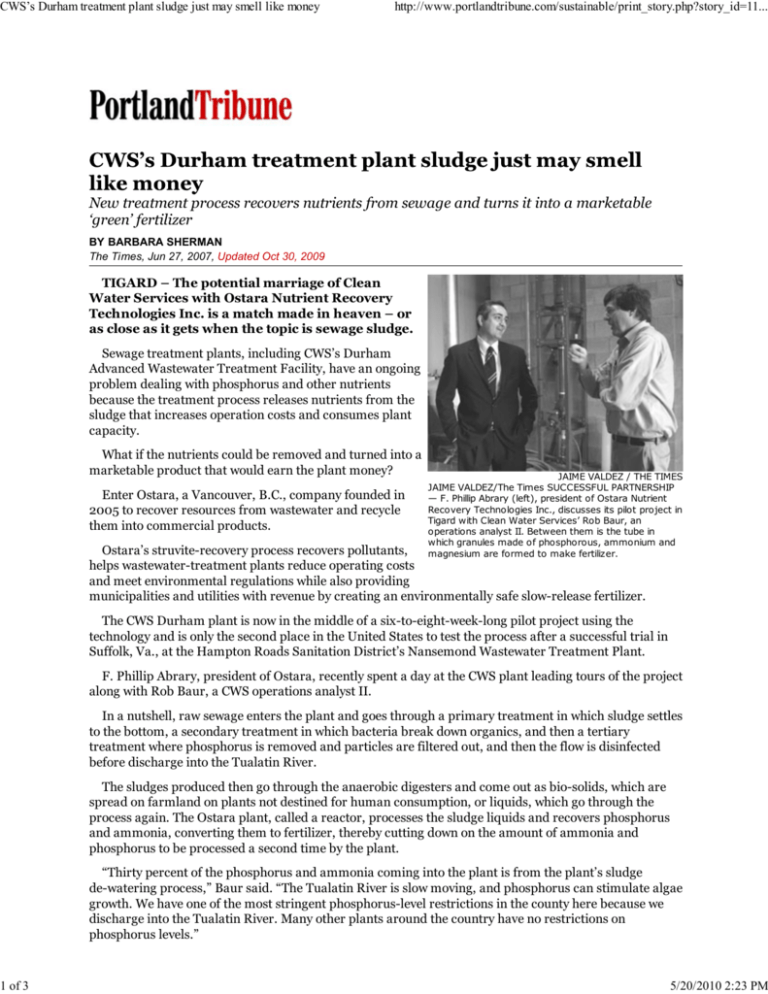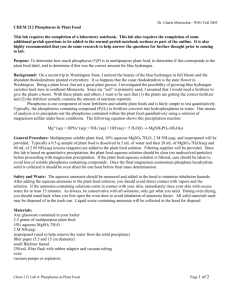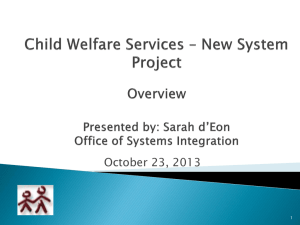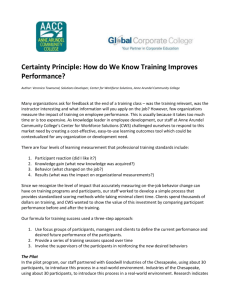CWS's Durham treatment plan
advertisement

CWS’s Durham treatment plant sludge just may smell like money http://www.portlandtribune.com/sustainable/print_story.php?story_id=11... New treatment process recovers nutrients from sewage and turns it into a marketable ‘green’ fertilizer BY BARBARA SHERMAN The Times, Jun 27, 2007, Updated Oct 30, 2009 TIGARD – The potential marriage of Clean Water Services with Ostara Nutrient Recovery Technologies Inc. is a match made in heaven – or as close as it gets when the topic is sewage sludge. Sewage treatment plants, including CWS’s Durham Advanced Wastewater Treatment Facility, have an ongoing problem dealing with phosphorus and other nutrients because the treatment process releases nutrients from the sludge that increases operation costs and consumes plant capacity. What if the nutrients could be removed and turned into a marketable product that would earn the plant money? Enter Ostara, a Vancouver, B.C., company founded in 2005 to recover resources from wastewater and recycle them into commercial products. JAIME VALDEZ / THE TIMES JAIME VALDEZ/The Times SUCCESSFUL PARTNERSHIP — F. Phillip Abrary (left), president of Ostara Nutrient Recovery Technologies Inc., discusses its pilot project in Tigard with Clean Water Services’ Rob Baur, an operations analyst II. Between them is the tube in which granules made of phosphorous, ammonium and magnesium are formed to make fertilizer. Ostara’s struvite-recovery process recovers pollutants, helps wastewater-treatment plants reduce operating costs and meet environmental regulations while also providing municipalities and utilities with revenue by creating an environmentally safe slow-release fertilizer. The CWS Durham plant is now in the middle of a six-to-eight-week-long pilot project using the technology and is only the second place in the United States to test the process after a successful trial in Suffolk, Va., at the Hampton Roads Sanitation District’s Nansemond Wastewater Treatment Plant. F. Phillip Abrary, president of Ostara, recently spent a day at the CWS plant leading tours of the project along with Rob Baur, a CWS operations analyst II. In a nutshell, raw sewage enters the plant and goes through a primary treatment in which sludge settles to the bottom, a secondary treatment in which bacteria break down organics, and then a tertiary treatment where phosphorus is removed and particles are filtered out, and then the flow is disinfected before discharge into the Tualatin River. The sludges produced then go through the anaerobic digesters and come out as bio-solids, which are spread on farmland on plants not destined for human consumption, or liquids, which go through the process again. The Ostara plant, called a reactor, processes the sludge liquids and recovers phosphorus and ammonia, converting them to fertilizer, thereby cutting down on the amount of ammonia and phosphorus to be processed a second time by the plant. “Thirty percent of the phosphorus and ammonia coming into the plant is from the plant’s sludge de-watering process,” Baur said. “The Tualatin River is slow moving, and phosphorus can stimulate algae growth. We have one of the most stringent phosphorus-level restrictions in the county here because we discharge into the Tualatin River. Many other plants around the country have no restrictions on phosphorus levels.” 1 of 3 5/20/2010 2:23 PM CWS’s Durham treatment plant sludge just may smell like money http://www.portlandtribune.com/sustainable/print_story.php?story_id=11... In fact, CWS, won the “Plant of the Year” award from the EPA for the Durham plant in 2005 and the Rock Creek plant in 2006 and holds a patent for the process it uses to ferment sludge to encourage biological phosphorus removal. It licenses the process to treatment plants around the country to use. “We have such strict limits that we must be state of the art,” Baur said. Development on the new environmentally friendly Ostara technology started in 1999 at the University of British Columbia, and the company was formed to take it from pilot project to business-ready on a scale that would be commercially feasible, according to Abrary. The company’s first commercial-scale plant began operation in Edmonton, Alberta, last month, and the first fertilizer, called Crystal Green, is being produced for commercial distribution. “Ostara is bringing state of the art to biological phosphorus removal,” noted Baur. “What we hope to get out of this is data for our facilities’ master plan that we are now in the process of creating. It includes our need for expansion, how big the footprint should be and if the Ostara process is cost effective when construction costs are included. “Our construction costs may be higher than the cost of the actual (Ostara) unit. The pilot project is an opportunity for us to see how efficiently and how well it works. We are only treating a small stream in the pilot project – approximately 1/300 of our capacity.” Leading the way to where the Ostara equipment had been installed in only a day, Abrary said, “This is where the magic happens. It’s like an oyster making a pearl.” Pointing to a tall, translucent column of effluent with small flecks churning around, Abrary explained, “What we’re seeing is crystals made of phosphorus, ammonia and magnesium, all important plant nutrients.” Without the Ostara process to remove the phosphorus and other nutrients, they can turn into a concrete-like substance called struvite that gums up the equipment. Picking up a block of the hardened substance removed from a pipe, Abrary said, “This is what would form if it wasn’t being turned into pellets. A day’s worth of the pellets (from the pilot project) would fit into any fertilizer spreader. It doesn’t leach back into the environment, and it becomes a high-grade, commercial fertilizer when we add magnesium chloride to the ammonia and phosphorus and removes those nutrients from the treatment plant. “The value of the fertilizer covers 100 percent of the procedure’s operating costs. It doesn’t cost the plant anything to run once it’s installed – it’s very simple, and it uses very little energy.” The capital cost of a reactor facility ranges between $2 million and $4 million, with the maintenance and capacity cost savings and fertilizer revenue making up the cost within three to five years. In addition, a company utilizing the technology can get 4 to 6 tons of greenhouse gas credits for every ton of fertilizer it produces, according to Abrary. “Fertilizer is typically made in big plants and shipped for long distances,” he said. “This is made and can be used locally.” As great as the new technology appears to be, CWS would need two to three years “at the earliest” to get it up and running since data is not yet available from a full-sized reactor. CWS would need to analyze the financial impact and where it would be located at the plant, Baur said. For example, the small tube in the pilot project that is only a few inches in diameter would need to be 22 feet in diameter at the top to treat one third of Durham plant’s capacity so three or more would be needed. “We need to be more green in the future,” he said. “We try to anticipate technology changes. It’s part science and part art.” As for the actual operation, Abrary explained, “We can built it, and CWS would contract with us to run and maintain it, or they could build it and run it themselves.” CWS is the site of the nation’s second pilot project due to an encounter at a water environment conference when Ostara attended a presentation by Baur on how CWS solved its struvite problem. Ostara tried one of the solutions, and it improved the operation of the pilot. 2 of 3 5/20/2010 2:23 PM CWS’s Durham treatment plant sludge just may smell like money http://www.portlandtribune.com/sustainable/print_story.php?story_id=11... That was the inroad that Ostara needed to start a mutually beneficial pilot project with CWS with the potential to turn all that phosphorus into cash and a ‘green’ fertilizer. Copyright 2010 Pamplin Media Group, 6605 S.E. Lake Road, Portland, OR 97222 • 503-226-6397 3 of 3 5/20/2010 2:23 PM








